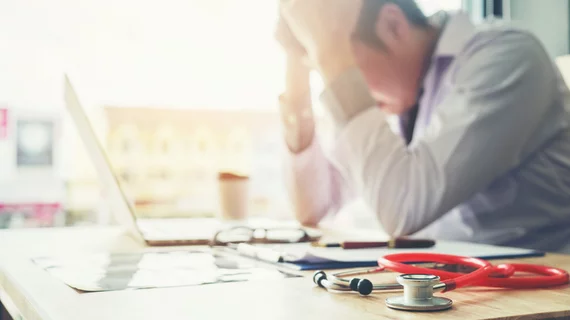Radiologists’ happiness outside of work has plummeted since the pandemic
Radiologists’ happiness outside of the workplace has plummeted since the arrival of COVID-19, according to new survey data from Medscape.
Prior to the pandemic, about 86% of members of the specialty surveyed said they’re “very happy” or “happy” with their lives away from healthcare. That put radiologists slightly higher that all physician types surveyed, at about 75%.
But since COVID’s arrival, only 61% of radiologists said they’re happy or very happy away from work (still slightly ahead of all docs, at 58%). Radiologists aren’t alone, with physicians in every specialty surveyed “substantially” less happy with their personal lives post-pandemic.
About 24% said that COVID-19 significantly affected their work-life happiness during the past year, while 44% said somewhat and 20% “only a little.” Workplace fatigue may be one factor that’s impacting happiness, as physicians put in extra hours to deliver care delayed during the pandemic.
“The impact of COVID on physician burnout will remain for years,” John Whyte, MD, WebMD chief medical officer, told the news site. “The focus has changed. Now it’s all about helping patients catch up on all the care, especially preventive, that they missed. This is causing very busy days and long lines, which frustrates everyone.”
About 36% of radiologists surveyed said they’re burned out (same as across all physician specialties), with equal numbers between both sexes. However, 31% of female radiologists described themselves as both burned out and depressed, compared to 14% of men and 18% overall among radiologists. Women in medicine have been more prone to burnout than men for various reasons, the report noted.
“Whether it’s emotional exhaustion (burnout) from constantly having to defend their authority; being overlooked for leadership opportunities; having different expectations of behavior; being interrupted or talked over in meetings; or as betrayal (moral injury) by an organization failed to uphold stated codes of conduct, women’s relative disempowerment to men puts them at higher risk of distress,” Wendy Dean, MD, co-founder of FixMoralInjury.org, told Medscape.
Common reasons for burnout among radiologists included too many hours at work (62%); lack of respect from administrators/employers, colleagues or staff (43%); lack of control/autonomy (41%); and too many bureaucratic tasks (33%). Meanwhile, radiologists’ favorite way of coping with burnout was exercise, given in 56% of responses. Other common tactics included isolation (42%), talking with friends or family (38%), sleeping more (36%) and eating junk food (35%). Only about 8% of radiologists said they’ve sought professional help for burnout compared to 47% who would consider it, and 44% who said they would not.
The findings are based on a survey of nearly 9,200 physicians, including almost 300 radiologists, conducted between June and October of 2022. Read more about the results below.

